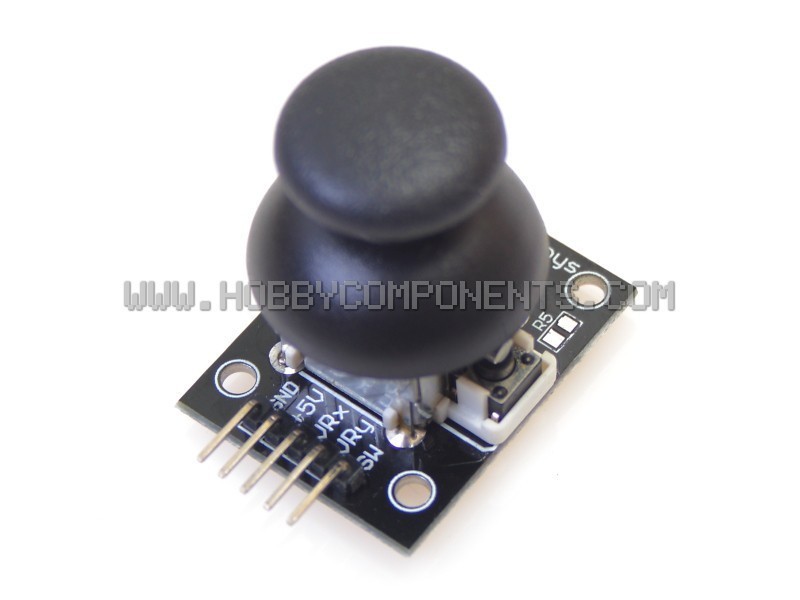MQ 7 Carbon Monoxide Sensor...
The MQ-7 carbon monoxide sensor module allows for the sensing of CO concentrations in the air....
- Currently Out of Stock




PS2 style 2 axis directional joystick
| PINOUT | |
|---|---|
| PIN | DESCRIPTION |
| 1 | GND |
| 2 | +5V |
| 3 | X-Axis (analogue) |
| 4 | Y-Axis (analogue) |
| 5 | Push button (Connects to GND) |
EXAMPLE CODE
ARD_Analogue_Joystick_HCARDU0019_Example.pde
/* FILE: ARD_Analogue_Joystick_HCARDU0019_Example.pde DATE: 03/07/12 VERSION: 0.1 This is a simple example of how to use the HobbyComponents Arduino analogue joystick module (HCARDU0019). The module has three outputs, two 5V analogue outputs representing the position of the joysticks X/Y axis, and one switch contact output representing the joystick’s push button. The switch contact has no pull-up and simply connects the pin to ground when the button is pressed therefore a pull-up will be required. This example program reads the status of the analogue and push button pins and outputs the result to the serial port. to the UART. MODULE PINOUT: PIN 1: Ground PIN 2: +5V PIN 3: X-axis PIN 4: Y-axis PIN 5: Switch You may copy, alter and reuse this code in any way you like but please leave reference to HobbyComponents.com in your comments if you redistribute this code. */ #define JOYS_VRX_DIO A0 /* Select the input pin for the joystick's X-Axis */ #define JOYS_VRY_DIO A1 /* Select the input pin for the joystick's Y-Axis */ #define JOYS_SW_DIO 2 /* Select the input pin for the joystick's push button */ /* Initialise serial and DIO */ void setup() { /* Setup the serial port for displaying the status of the sensor */ Serial.begin(9600); /* Configure the DIO pin that the joystick's push button will be connected to. As it has no pullup we will need to enable the Arduino's internal pull-up */ pinMode(JOYS_SW_DIO, INPUT); digitalWrite(JOYS_SW_DIO, HIGH); // turn on pull-up resistors } /* Main program loop */ void loop() { /* Read the current position of the joystick's X & Y axis via the analogue pins */ Serial.print("X axis: "); Serial.print(analogRead(JOYS_VRX_DIO)); Serial.print(" Y axis: "); Serial.print(analogRead(JOYS_VRY_DIO)); /* Read the state of the push button and if pressed, output the state to the serial port */ if (!digitalRead(JOYS_SW_DIO)) { Serial.println(" Button pressed !"); }else { Serial.println(); } }
The MQ-7 carbon monoxide sensor module allows for the sensing of CO concentrations in the air....
The DHT21 digital temperature sensor is one of the commonest from the range of DHT temperature...
A simple but very useful module which uses a potential divider to reduce any input
Infrared receiver module uses a 1838 infrared receiver. This is a universal type, with steel,...
An excellent little module for detecting the speed of a motor. Ideal for our 2- and 4-wheeled...
This Platinum thermal resistance probe is an accurate, sensitive, and stable temperature...
This is a very low cost break out module for the ADXL335 tripple axis accelerometer. This...
This module has been designed as an alternative to the PIR motion detectors commonly used in...
A linear sliding potentiometer module allowing for very smooth and precise control. The module...
A resistive strain gauge sensor with a 350 ohm nominal resistance which varies when a force is...
A capacitive touch sensor module based on the dedicated TTP223 touch sensor IC. The module...
Working voltage: 5V
Circle of Pulses: 20
Product Code: HCMODU0063
Diagrams,...
This 5mW laser module emits a small intense focused beam of visible red light. The example...
On-board ACS712T ELC-05B current sensor; Working voltage: DC 5V; Power LED indicator; Measures...